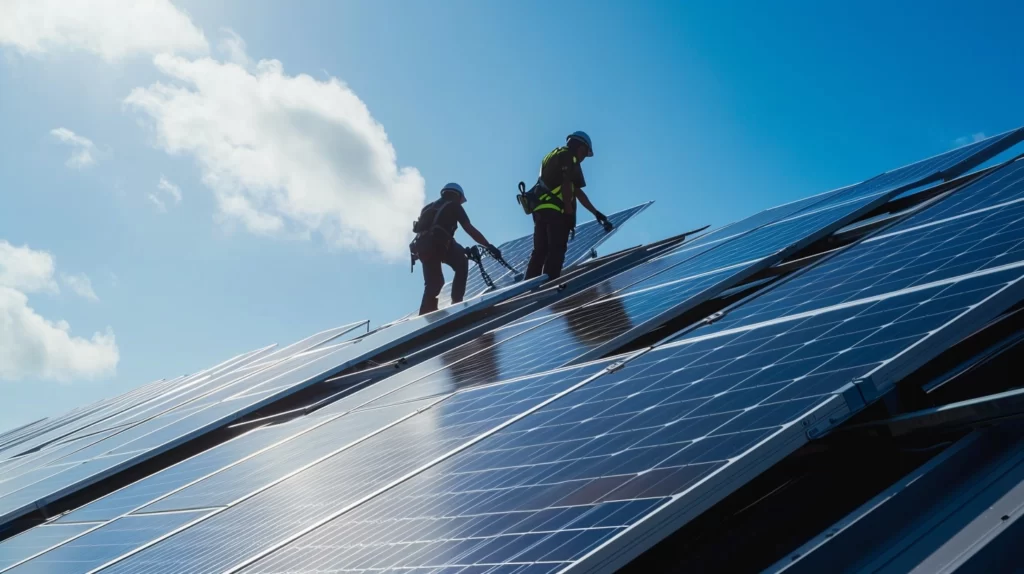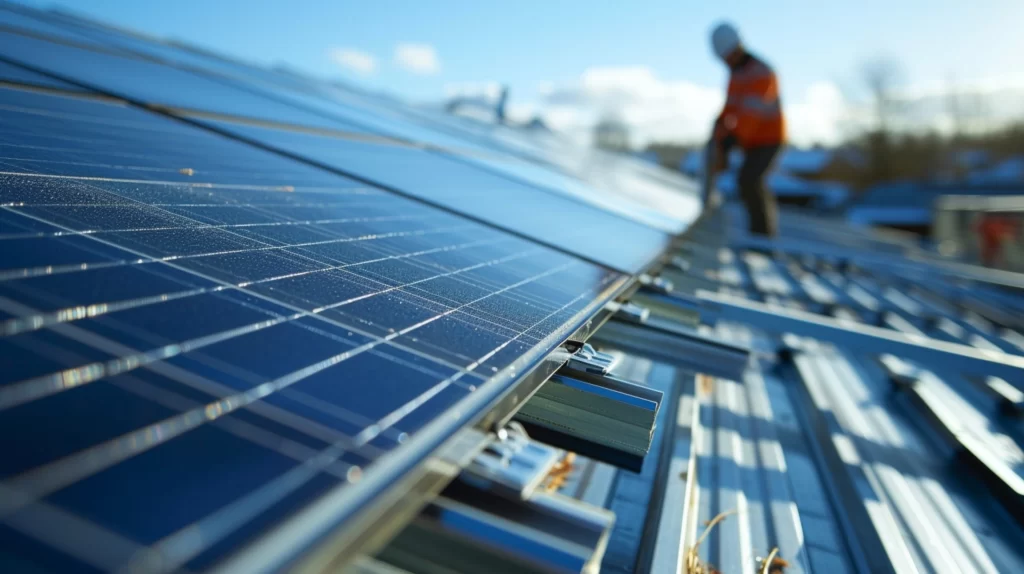Can Solar Panels Be Installed on A Metal Roof? Be Careful!
In my quest for a greener lifestyle, I’ve often joked that you could spot my enthusiasm for solar energy from space. Yet, when it comes to pairing solar panels with a metal roof, I’ve approached the matter with the seriousness it deserves.
The stark reality is that while metal roofs can indeed support solar panels, the installation process is a delicate dance between maximizing efficiency and preserving the integrity of the roof.
As I navigate the complexities of choosing the right mounting systems and understanding the potential risks involved, I’m struck by the necessity of sharing these insights.
For those who are contemplating a similar path, I’m compiling my findings and experiences to shed light on the critical considerations that must be addressed.
So, if you’re standing at the crossroads of solar energy and metal roofing, stay tuned for a thorough exploration of how to embark on this journey with your eyes wide open and your roof perfectly intact.
Continue Reading to Understand These Key Points:
- Metal roofs offer a secure and durable foundation for mounting solar panels.
- It is important to verify the metal roof’s load-bearing capacity before installation to ensure its structural integrity.
- Choosing the right mounting system for the specific metal roofing material is crucial for a secure and efficient installation.
- Regular maintenance and inspection of both the panels and the roof are necessary to ensure optimal performance and longevity.
Metal Roof Compatibility
Metal roofs excel in their compatibility with solar panel systems, offering a robust foundation for the secure mounting and long-term operation of the solar array.
The inherent strength of metal roofing materials ensures that they can support the weight of metal roof solar panels and the associated hardware. This compatibility extends to various designs, including corrugated metal roofs, which can be fitted with specialized mounting systems.
When I’m considering installing solar panels on a metal roof, I take into account the durability of the roof itself. Metal roofs are known for their longevity, typically lasting 25 to 30 years, which aligns well with the lifespan of solar panels.
This means I won’t have to worry about replacing the roof midway through the solar system’s life, saving me money and time.

The available mounting products for metal roof solar panels are designed for easy installation. They don’t require special tools or materials, which simplifies the process.
The streamlined installation doesn’t compromise the roof’s integrity, as these systems are engineered to attach securely without causing damage.
As an analytical observer, I’ve noted that the synergy between metal roofs and solar installations isn’t only technically sound but also financially beneficial.
With the federal investment tax credit (ITC), I can recoup 26% of the solar system cost, enhancing the return on my investment through reduced electric bills.
Installation Precautions
When installing solar panels, it’s crucial to verify that the metal roof can sustain the extra load without its structural integrity being compromised. I need to pay close attention to the specialized mounting systems that are designed to work with metal roofs.
These systems ensure a secure attachment and even weight distribution to prevent roof damage.
To maintain the roof’s structural integrity, I conduct a thorough analysis of the roof’s load-bearing capacity before proceeding with the installation. This step is vital to ensure that the metal roof can handle the additional weight of the panels and mounting equipment.
Proper installation is essential to prevent leaks. Therefore, I make sure to use appropriate sealing and flashing techniques around any penetrations made during the installation process. Here’s a quick guide to what I consider during the installation:
| Consideration | Importance |
|---|---|
| Load Analysis | Ensures the roof can support the solar system |
| Specialized Mounting | Provides secure attachment and prevents roof damage |
| Proper Sealing | Essential to prevent leaks and water damage |
| Professional Expertise | Guarantees safety and maximizes system performance |
Adhering to these precautions, I safeguard the roof and ensure the longevity and efficiency of the solar panel system.
What Precautions Can I Take to Protect My Solar Panels from Lightning Strikes on a Metal Roof?
When installing solar panels on a metal roof, it’s essential to implement effective lightning protection for solar panels to prevent damage from lightning strikes. Consider installing a lightning protection system that includes surge protectors, grounding equipment, and specialized lightning rods to divert electrical currents safely away from your solar panels.
Mounting Systems Explained
Understanding the variety of mounting systems available for solar panel installation on sloped metal roofs is crucial for ensuring a secure and efficient setup.
Metal roofs, with their inherent smoothness and evenness, offer an ideal base for solar panels. However, the mounting systems must be chosen and implemented meticulously to provide a secure foundation for solar infrastructure.
The installation process for solar panels on metal roofs can vary but typically involves one of three main types of mounting systems: railed, rail-less, or shared rail.
Railed systems involve attaching a set of rails to the roof onto which the solar panels are mounted. This is a traditional method that provides a sturdy foundation but often requires penetration of the roof, which must be done carefully to maintain roof integrity.
Rail-less systems, on the other hand, allow for the direct attachment of solar panels to the roof with clamps or brackets, reducing the number of components and potential for leaks. Manufacturers have refined these systems to be drill-free, avoiding the need for holes entirely, which preserves the metal roof’s durability and weather resistance.
Shared rail systems combine aspects of both railed and rail-less, where two panels share a support structure, reducing materials and labor.
Each of these systems must be analyzed in terms of the specific metal roofing material to optimize energy efficiency and system longevity.
Potential Installation Risks
While exploring the various mounting systems equips us with the knowledge to securely affix solar panels to metal roofs, we must also scrutinize the potential installation risks that could compromise the roof’s integrity and the system’s performance.
One such risk involves roof damage, especially when mounting procedures require drilling into the roof’s surface. If not done meticulously, this can lead to breaches that become gateways for causing leaks, undermining the roof’s primary function of shielding the interior from the elements.
The installation process must account for the metal roof’s load-bearing capacity. Exceeding this capacity could result in structural compromise, posing a risk not only to the roof but also to the entire building.

Creating secure yet non-invasive attachments is critical. Loose connections can arise from improper installation, leading to potential safety hazards and reduced system reliability.
I’m particularly cautious about the risk of galvanic corrosion, which occurs when dissimilar metals come into contact. This can significantly shorten the lifespan of both the roof and the mounting system.
I always ensure that the solar panel’s electrical systems are correctly grounded and protected against surges to mitigate electrical risks.
Maintenance Post-Installation
Ensuring the longevity and efficiency of solar panels on metal roofs necessitates regular maintenance and inspections.
The metal’s sleek surface is favorable for solar panel systems, but it requires diligence to preserve both the panels and the roof. Here’s what I focus on for maintenance post-installation:
- Regular Inspection: I conduct thorough examinations to detect any wear or potential damage. This includes verifying that panels securely attach to the roof and that all electrical connections remain intact.
- Cleaning: To prevent efficiency losses, I ensure the solar panels are free from debris. This involves brushing off leaves and dirt that could accumulate on the metal roof and obstruct sunlight.
- Structural Checks: It’s essential to periodically inspect the integrity of the roof and mounting system. The roof needs to support the solar array without compromising its structure or weatherproofing.
- Performance Monitoring: I closely monitor the system’s output to catch any irregularities early on. Promptly addressing drops in performance can preclude larger issues.
Final Thoughts
Metal roofs can indeed support solar panels, but it’s a task that requires precision. I’ve learned that choosing the right mounting system is key to avoiding damage. Potential risks like leaks and structural compromise are real, but with professional installation, they’re manageable.
Post-installation maintenance is minimal, yet vital for longevity. It’s a delicate balance, but with careful planning, my metal roof and solar panels should work in synergy, embodying sustainable living without sacrificing structural integrity.
